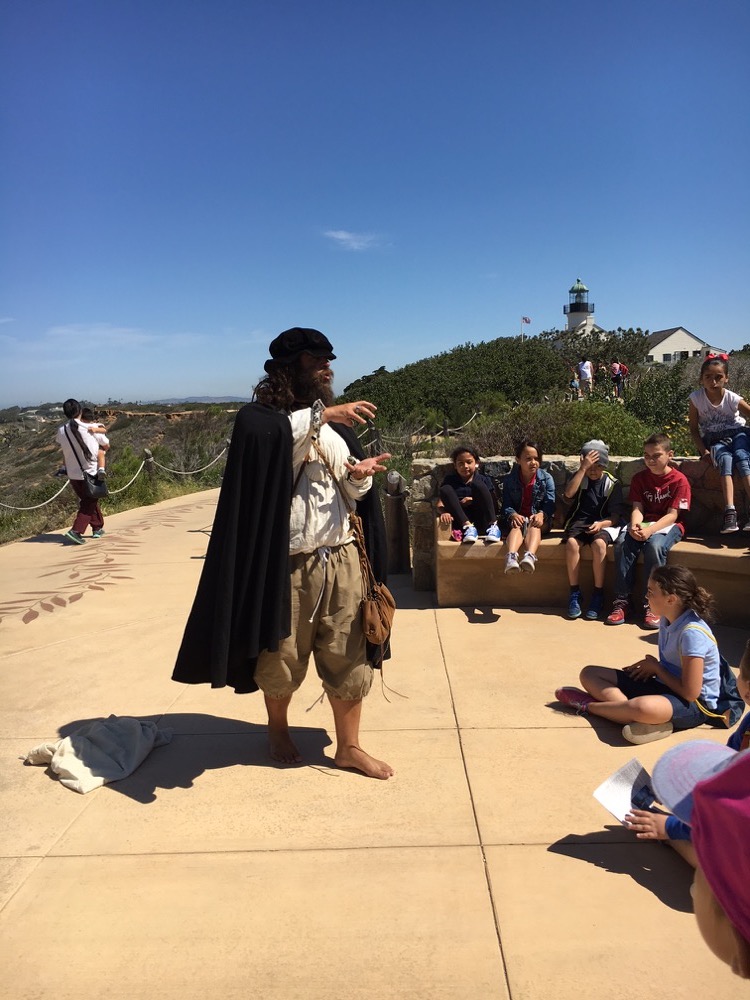 NPS Photo/Nicole Ornelas – Ranger Alex sits with the happy students of a school group at the edge of CNM’s tidepools.
NPS Photo/Nicole Ornelas – Ranger Alex sits with the happy students of a school group at the edge of CNM’s tidepools.The National Park Service’s mission is to preserve and protect our nation’s cultural, historical, and natural resources, and our outdoor education programs reflect that. Students can learn about Point Loma’s history with units called Juan Rodriguez Cabrillo: A Voyage of Discovery (the first European to set foot on the West Coast of what is now the United States, and the Monument’s namesake) and Growing Up in the Old Point Loma Lighthouse. The culture of the native peoples, the Kumeyaay, can be explored by examining our native plants and how they’ve been traditionally used with The Kumeyaay Supermarket: Native American Plant Uses.
 NPS Photo/Bill Griswold – Cabrillo National Monument’s old lighthouse.
NPS Photo/Bill Griswold – Cabrillo National Monument’s old lighthouse.
NPS Photo/Alexandria Warneke – Ranger Tavio dressed as a 16th century sailor in this historical program about Juan Rodriguez Cabrillo.
The Science Education Department teaches units that emphasize the science we do here at CNM which partner really well with curriculum taught in science classrooms. Innovative tools are used to catalogue biodiversity in the Biodiversity Snapshot lesson – which highlights free software, called iNaturalist, that can even be downloaded by folks at home! Life in our tide pools is investigated by Intertidal Explorers where students learn what causes the tides as well as about the incredible adaptations of the organisms living within the dynamic Rocky Intertidal ecosystem. Natural selection (the mechanism that drives adaptation) is again examined by students with the Plant Adaptations lesson. Even the changing climate, and what that means for organisms in both terrestrial (land) and marine (ocean) systems, is explored by Climate Kids.
 NPS Photo/ Nicole Ornelas – Ranger Alex and class draw marine snails on a tidepool excursion.
NPS Photo/ Nicole Ornelas – Ranger Alex and class draw marine snails on a tidepool excursion.
NPS Photo/Alexandria Warneke – Mr. Andrew of the Science Education team points out biodiversity in the Pacific Ocean to a visiting class.
Back-to-school also means voyages into the community, both digitally and physically. Offsite, we can bring our tide pools to you with 3D Cabrillo! Biomodels (models of living things) of many of our tide pool organisms have been created for you to freely download and take to your local 3D printer (for example, at the Innovation Lab in the San Diego Central Library). 3D Cabrillo even includes instructions on how to create your own model for future printing! Science educators will also come to your classroom for our Science Sampler program. We’ll instruct the students on how we study intertidal ecology, giving them the tools that are actually used in the field. Students then get to visit the Cabrillo tidepools to practice their skills in the field!
 NPS Photo/Nicole Ornelas – A student graphs data on a whiteboard for comparison and analysis with the Science Education Department.
NPS Photo/Nicole Ornelas – A student graphs data on a whiteboard for comparison and analysis with the Science Education Department.We’re big proponents of outdoor education here at CNM. In fact, research shows that having hands-on experience enhances learning and memory about a topic, so whether you’re teaching history, culture, or science, allow us to assist with the lesson! Sign up for a ranger-guided lesson today and join some of the ~ 19,000 (annually) students in exploration of YOUR beautiful National Park!
To make a reservation or learn more about program offerings, visit: http://cabrilloeducation.com/ranger-led-programs/
